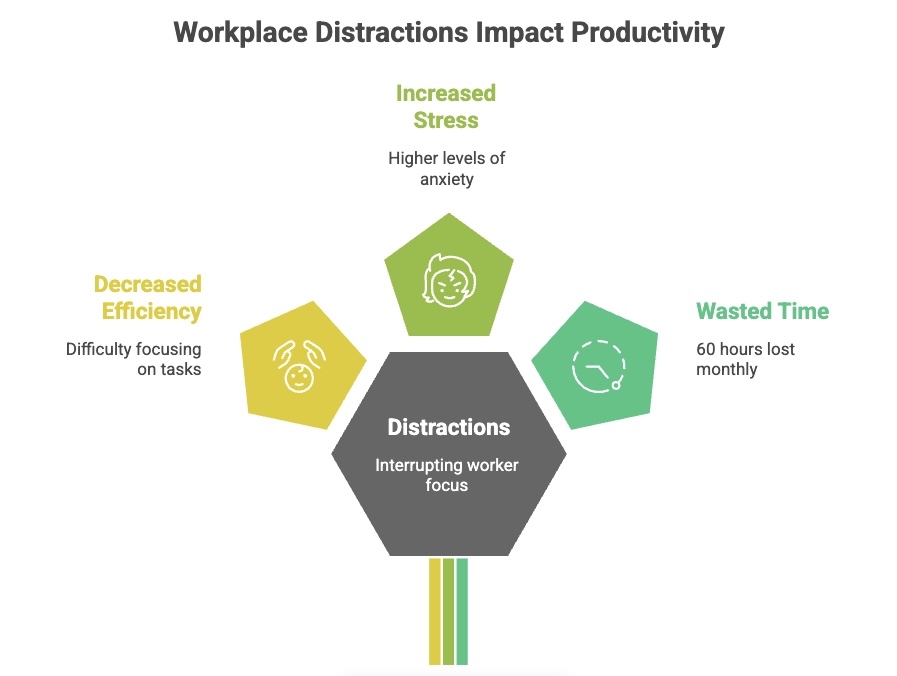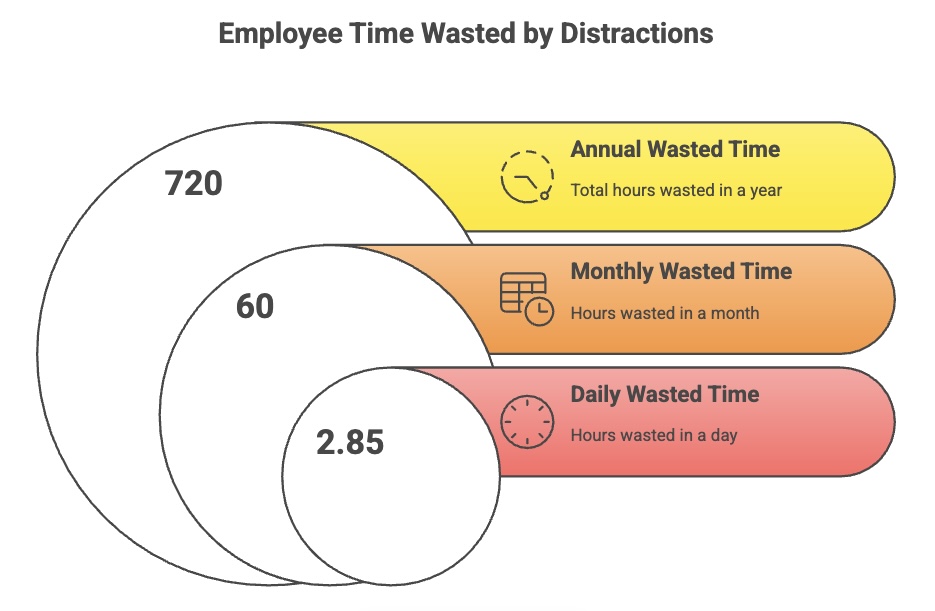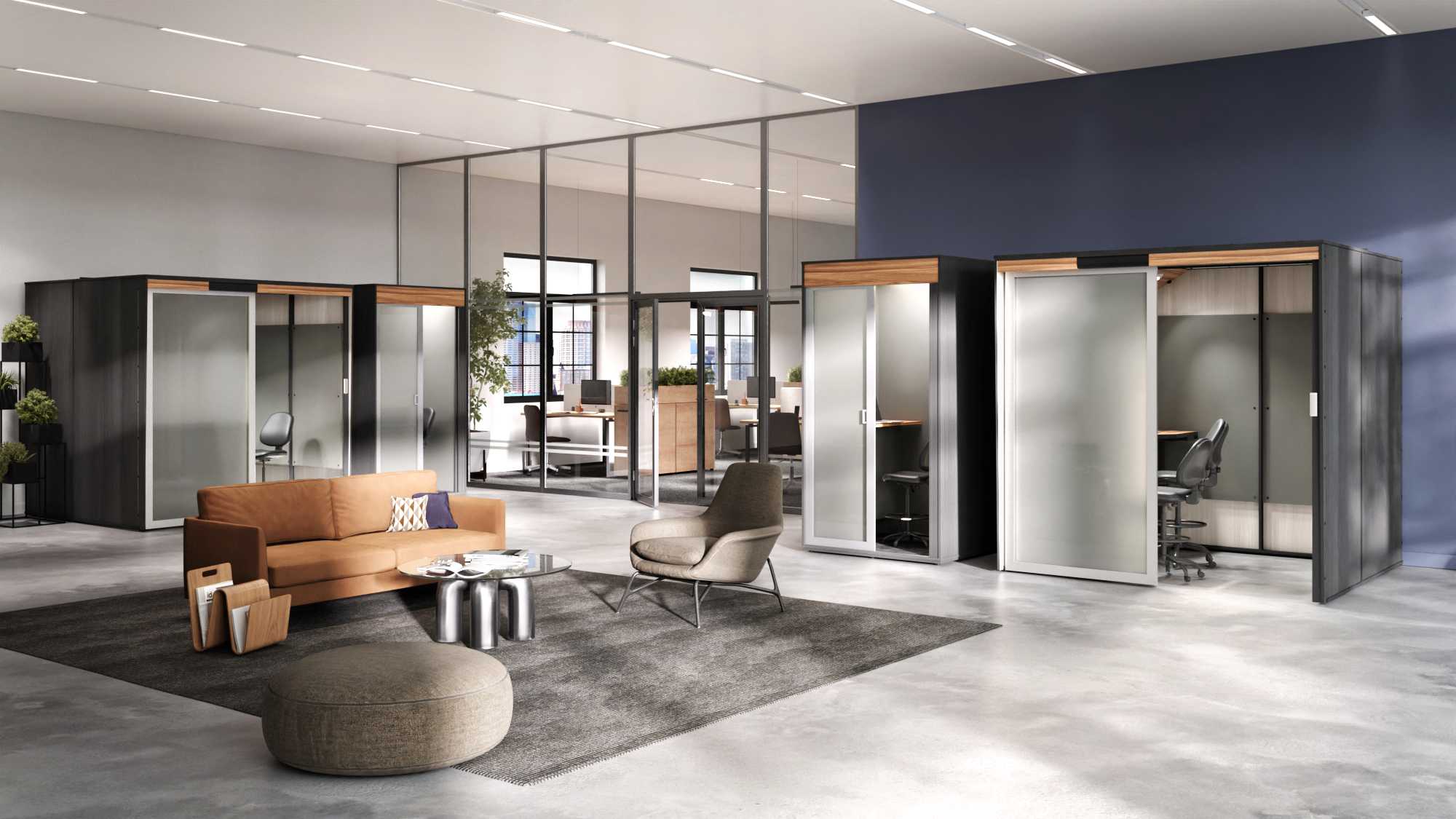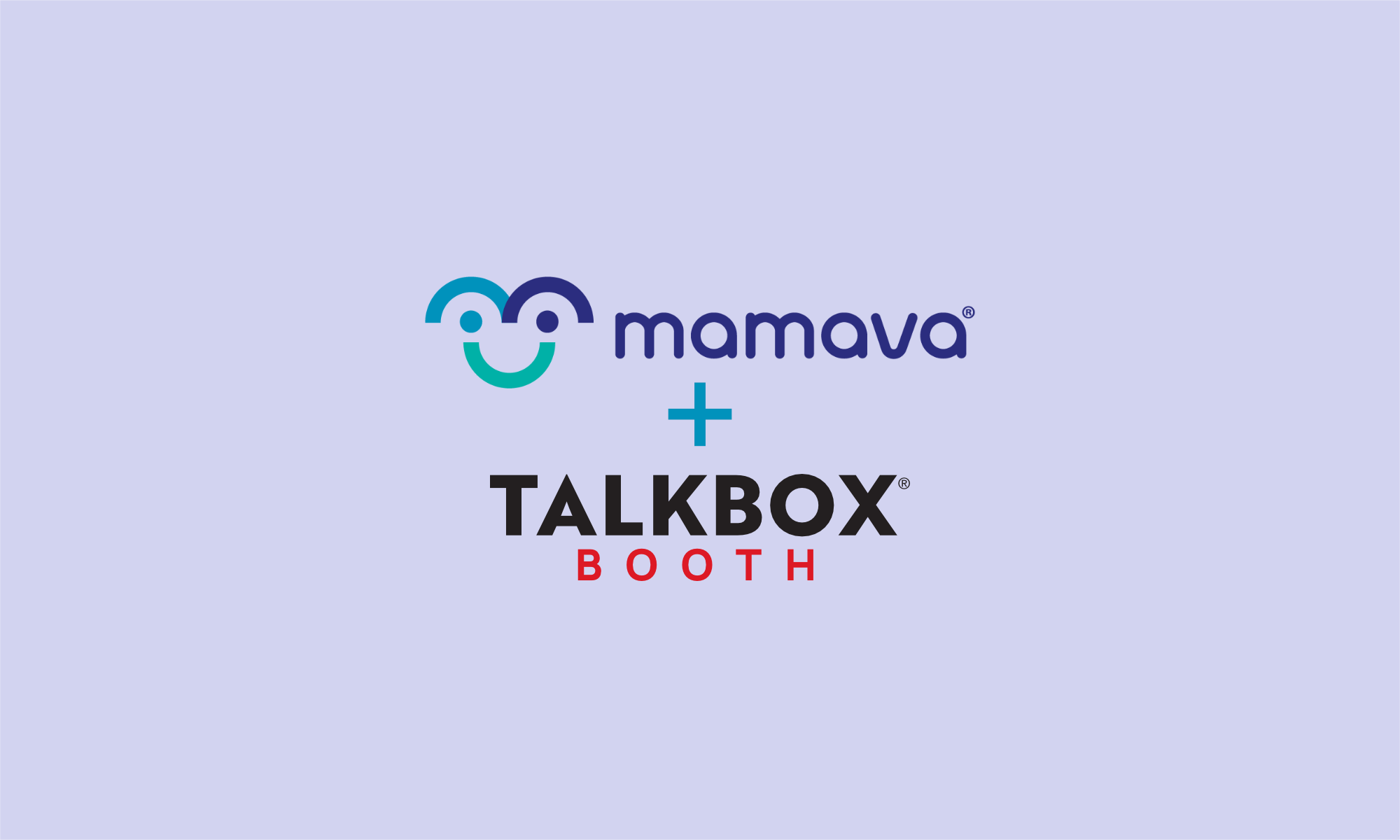It happened again... You’re racing the clock in preparation for a big meeting and you get interrupted by a coworker who starts telling a trivial story about something that happened last night. You kindly mention that you’re slammed with work and need to focus, but the damage is already done. This is the fifth time this hour that someone has interrupted you causing your train of thought to come to a screeching halt. You try to refocus on your work but you’re already distracted, making it nearly impossible to regain that moment you had before.
Why does this happen? Why do you completely lose your train of thought when someone interrupts you and starts talking about their dog...or boyfriend...or that TV show they are obsessed with? Many will say that it’s difficult to multi-task, and your brain can only handle so many things at once. While it is true that multitasking has its limits, the deeper answer to this question is actually very primal, and much more damaging to employees productivity and a business's profitability than researchers previously imagined!
A recent study from the Cleveland Clinic has made a connection between the basic “fight or flight” reaction our bodies produce when we are in danger and the way our bodies respond to workplace stress.
Fight or Flight

When a human encounters something unexpected, a brain system called the Subthalamic Nucleus (STM) engages causing them to make an abrupt stop so that they can observe and react quickly to the potential threat they’re facing. The STM has served an essential role in the survival and growth of the human race. What researchers didn’t realize until recently is that the STM not only causes you to physically make an abrupt stop, but it also causes your mind to abruptly halt ALL thought so that it can focus on the potential threat it’s facing.
In our modern society full of interruptions, the STM triggers the same thought halting effect for any interruption regardless if it’s a danger to us or not. When we operate in an environment full of distractions, it can be nearly impossible to focus on the task at hand.
The Open Office Movement

Open offices were developed with good intentions. Forward thinking employers wanted to create an environment that enhanced company culture, promoted creativity, and made the workday less painful. Many created aesthetically beautiful office settings and went above and beyond by providing healthy meals, free yoga classes, game rooms, massages and apres-work craft beer. The assumption was that employees would unanimously enjoy and thrive in these beautiful work environments.
Looking back on the movement years later, the open office concept was a complete and utter disaster! Businesses across the board started seeing lowered productivity, weakened morale, and increased turnover. They were spending lots of money hiring and training employees only to have to repeat the process over and over again for the same job title.
What was causing all this disdain for the open office? The answer is a bit of a perfect storm that includes misdiagnosing what people need in order to thrive in a work environment along with a lack of understanding basic human behavior. Let me explain:
Why Employees Work
People go to work so that they can make money. They make money so they can pay for essential expenses in life and ideally have enough left over to “play” with. They do not go to work to play, nor would they chose to play with coworkers given the option outside of work. The majority of employees would prefer to create high quality work, completed on time, so they can leave the office and reap the rewards of their efforts.
What Can Go Wrong?
If an employee is allowed to focus for the entire day, they become highly productive, they comfortably hit their deadlines and they leave relaxed at the end of the day. If that same employee decides to slack off during the day, they only have themselves to blame if they miss a deadline. In this scenario, the employee is directly in control of the outcome and has created an environment of positive reinforcement — ie; If you work hard, you meet your deadlines and you get to leave work on-time.

If an employee is interrupted throughout the day, they lose control of their situation. Once interrupted, the Subthalamic Nucleus triggers an abrupt halt to their thinking process and derails their train of thought. If derailed enough times, an employee will have to start working faster and harder to reach their deadlines. Derailed too many times and they miss their deadline entirely. Both scenarios causes increased stress on the employee. Additionally, since the interruptions are out of the employees control, they start to blame the workplace for their added stress...and rightfully so! After all, forces out of their control are adding stress, endangering their career, and threatening their way of life outside of work.
Open offices unknowingly created a breeding ground for distractions. Employees who were once allowed to work productively in their private spaces were now thrust into the loud and active open office environment. As distractions grew, productivity went down and stress went up. Employees would then dread going to work each day because they had no control over their productivity. Feeling helpless and annoyed, many eventually quit in hopes of finding a better situation somewhere else.
Employers misdiagnosed what made their employees happy. They assumed their employees needed a fun and inviting place to work, when in reality they just want a peaceful place free of distractions where they can be in control of their productivity.

Some Key Statistics
- The average worker wastes 60 hours every month due to workplace distractions
- A third of employees are distracted at work for a total of up to three hours a day
- 56 Interruptions a day for the average employee
- 80% of interruptions at work are considered trivial
- 60% or less of work time is actually spent productively. Interruptions cause employees to take 27% more time to complete a task, commit up to twice as many errors and experience twice the anxiety.
Businesses Can’t Afford This!
What I’m about to show you is absolutely shocking! It’s one thing to say “the average worker wastes 60 hours every month due to workplace distractions” but it’s another thing to see the financial impact clearly outlined on a spreadsheet.
Let’s start with the basics. There are many firms that have performed studies on workplace distractions over the years. While the numbers vary slightly, they all keep falling within the same general range of roughly 2.5 to 3 hours of work wasted each day per employee due to workplace distractions. To keep things simple, I’m going to use 60 hours/employee/month as my baseline for time wasted due to distractions. This equates to 2.85 hours / employee / day and passes the smell test for reasonableness.

That's Nearly Three Hours a Day Wasted Per Employee!
This is a good start, but what does this mean for your business? Well, for starters, a common complaint around most offices is that they are understaffed. This simple figure above sheds some light on why it may feel that way, but only gives part of the picture. If one employee is wasting 720 hours per year, how many employees would it take to equal the full-time equivalent of an additional team member?
The table below plots out the effect distractions have on productivity for a wide range of team sizes starting at 5 employees and going as high as 1000 employees.
Multiply By Number of Employees

The above chart shows you how much time is being wasted each day/month/year and how many full-time equivalent employees that time is worth.
If you look at the first row (5 employees), those five employees collectively waste 3,600 hours per year due to distractions. If distractions were eliminated entirely, your team would gain the same amount of productivity as if it added 1.7 new employees. For a business of 1000 employees, eliminating distractions would gain the same amount of productivity as if the business added 346 employees. That equates to 34.6% more productivity by eliminating distractions — and that amount is staggering!
Ok, so we know 34.6% of your business's manpower is being wasted by distractions. That’s a huge figure, but how does it relate to money?
The Bureau Of Labor Statistics came out with a release on June 18th 2019 presenting average employee compensation in the Civilian, Private Industry and State & Local Government sectors. With this compensation data, we are able to estimate the average amount of money a business wastes each year due to distractions in the workplace.
How Much Money is Wasted Due to Distractions?

This is where it really hits home. Even at the smallest organization level on the chart with 5 employees, the business is throwing away anywhere from $124,000 to $183,000 in wages depending on the sector. Got 10 employees? $248,000 is likely being thrown away on the low end. 1000 employees? Your organization is throwing anywhere from $24 - $36 Million in wages every year!!!
Even at the lowest level of 5 employees, I have yet to meet a small business of that size that had a spare $183,000 laying around that they didn’t need. This is also just the tip of the iceberg. These amounts do not take into account the cost of hiring and training new employees. There are also opportunity costs relating to the downtime a company faces when they replace an employee. When you really start to think about it, solving the problems caused by distractions should be near the top of every managers list in every single organization.
The Solution
We have identified that employees need to be in control of their productivity, and that means eliminating distractions. The following are some suggestions businesses can take to accomplish this:
Provide Training on Time Management
- Educate staff on the concept of "Attention Residue" and the cognitive cost of task-switching, reinforcing the value of completing one task before moving to the next.
- Incorporate modules on digital well-being, teaching techniques to minimize personal device checking and manage notifications from collaboration tools to maintain focus during work blocks.
Define cultural norms around noise levels and interruptions
- Establish guidelines for using "focus" time (e.g., specific hours where interruptions for non-urgent matters are strongly discouraged) and communicate this clearly to all teams.
- Implement a system, like the use of headsets, "do not disturb" signs, or physical location changes, to signal when an employee is engaged in deep work and should not be disturbed.
Establish designated spaces for quiet vs. noisy work
- Allows employees to choose what environment they want to work in at any given time
- Encourage the use of email for less urgent questions, reserving in-person, instant messaging (Slack) interruptions or calls for time-sensitive, critical issues.
Add Privacy Booths to your open office environment
- Office privacy booths provide a quiet place for employees to retreat to when distractions become too much.
- Privacy booths cost roughly 0.5% of the average employee’s annual salary and can increase productivity by 34%.
- Allows employees to work on sensitive data while in close proximity to other employees.
- Empowers employees to have video conference calls without disturbing those around them.
- Privacy booths put employees in control of their productivity.

Add Meeting Booths to Your Office
- Meeting pods free up larger conference rooms by accommodating small groups (2-4 people) for quick sync-ups, focused meetings, or one-on-one check-ins.
- These enclosed spaces offer a secure, private setting for sensitive discussions, such as HR conversations, client calls, or confidential project planning, preventing information leakage and ensuring discretion.
- More affordable and quicker alternative to building permanent meeting rooms. They can be easily relocated or reconfigured as the office layout and team needs evolve.
Allow Flexible Schedules
- 67% of small businesses offer flex schedules.
- 73% of employees agree that flex schedules increased their satisfaction at work.
- 78% of employees said flex schedules make them more productive.
Allow Remote work options
- 86% surveyed said they prefer to work alone to hit maximum productivity.
- 54% surveyed said that telecommuting allowed them to be more efficient.
- 82% of remote or partially remote workers reported lower stress levels.
The Big Takeaway

Distractions and interruptions are plaguing our current office environment. There are, however, some relatively easy steps you can take to help mitigate the problem. Identifying an employee’s need to be productive as well as acknowledging the adverse effects interruptions have on productivity is a big start. Do your company and employees a favor and try out some of the solutions listed above. You’ll be amazed at the outcomes!
Having a privacy booth available can be a game-changer for your employees.
See our different models here >>
Not sure what solution makes the most sense for your organization?
Feel free to ask us any questions here >>
















